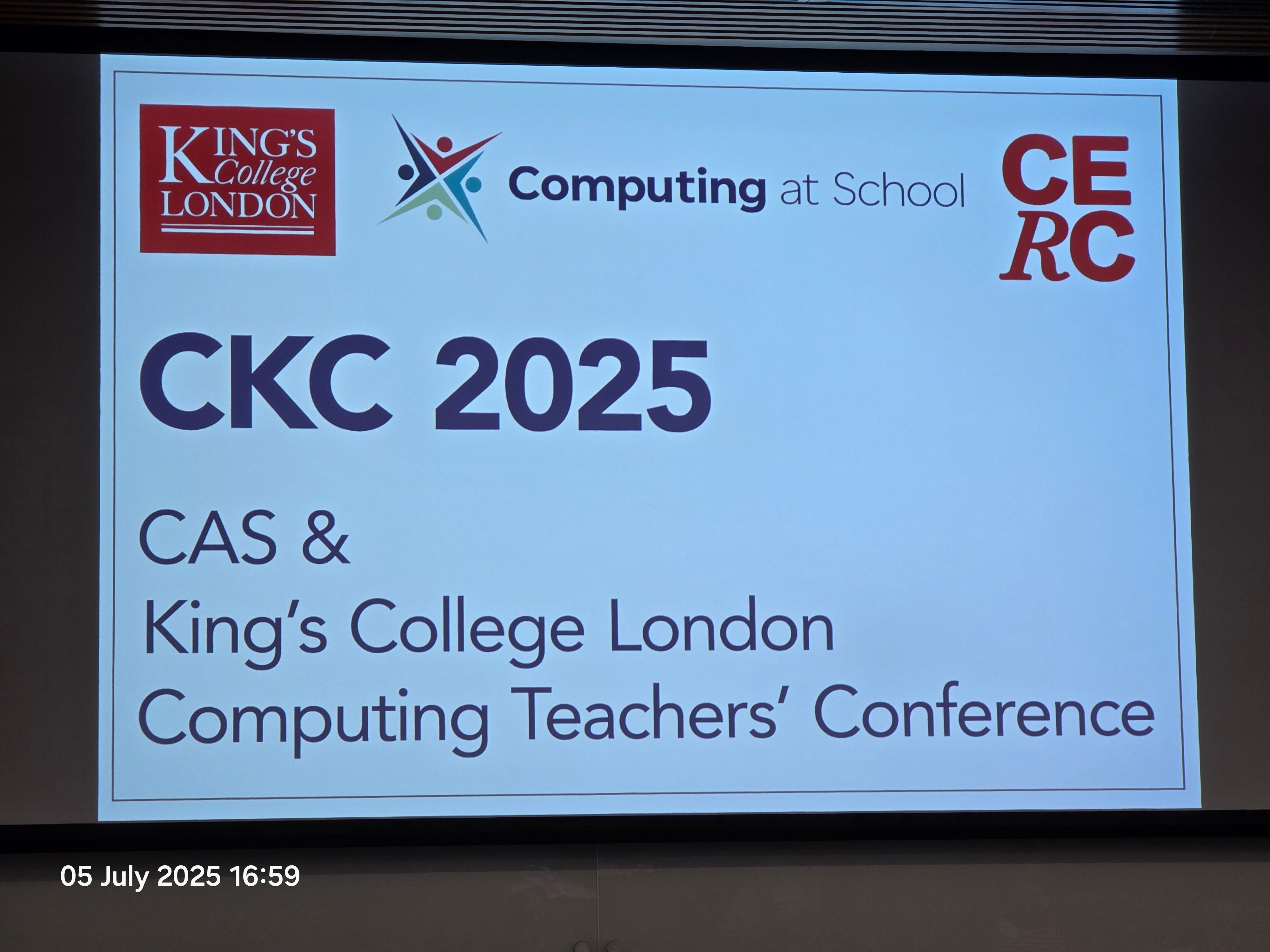06 July 2025
#CKC2025

Responding to the wonderfully inspirational Michael Kölling clarion call closing the inaugural Computing at School Computing Teachers Conference hosted by King’s College, #CKC2025, I had been sharing my reactions from the room throughout the day on the social media platform formerly known as Twitter. Despite the very evident #Xodus and notable silence from some previously active accounts, the platform remains my goto social media source for two reasons. Firstly, as others have more eloquently expressed, my continued active engagement on X is not an endorsement of its (present, 2025) owner. I will not be bullied out of the playground, silenced by negative content and critics and those who might hold extreme views opposed to mine. The other is by being actively engaged on some social media platforms means being able to demonstrate a greater understanding of the issues around online safety and specifically being able to identify how to advise others to mitigate against risks of contact and conduct from social media.
Of the Conference day itself, having been the Community Lead for Waltham Forest in East London since Summer 2020, I had wanted to be on the speaker line up to talk about how to address the issues of transition between Primary and Secondary and secure engagement rates at KS3 especially given the widening gulf of those leaving Primary who are either almost two years above Age Related Expectations in Computing whilst there are those still well below the digital divide. But as one of the organisers, Neil Brown very kindly explained, the event was aimed “at teachers with take-aways for them to use in their classrooms immediately afterwards”.
So did my experience of attending as a delegate meet that aim? Darn right it did and then some! The first challenge as with any Conference was which of the parallel sessions to attend. Fortunately, the programme was split into three distinct strands: resource ideas, pedagogy and contextual reflections. Given my classroom experiences, I was mainly drawn to the Language, Tools and Systems or resource ideas strand and particularly eager to learn more about Strype and FlockXR. Having previously read Neil and Michael’s recent paper “Informatics in Schools: Why, What, Who–and How to Initiate Change?” (2025, Brown, Caspersen and Kölling), I wanted to hear Michael’s eight tips for teaching creative programming. As an eager advocate for equality, diversity and inclusion to teaching and learning, I of course had to hear about Hina Malik’s experiences.
But before all of the breakout sessions, the keynote from Dom Syme was absolutely mind-blowing. Hearing about his cutting-edge experiences from the vanguard of GitHub Next was both a real privilege and reassuring to know that those at the top of their field in Computing and Technology are there are to help us “re-tool” the way we all engage in an ever changing online World. Breaking some of the myths of Artificial Intelligence and Machine Learning to reveal that the essential skills we teach today of being able to read, write and describe precisely what you want to achieve is paramount. I personally remain sceptical of how truly transformative Artificial Intelligence can be but am persuaded by its capabilities to support the management of routine automated tasks such as pin-point surgery.
Of the resources workshops strand, Neil was not wrong in achieving his take-away straight away use of Strype. With children being able to be successfully introduced to Scratch as young as aged 6 so building up proficiencies two years above Age Related Expectations by the time they leave Primary School, some teachers like me have been introducing Python to children as young as aged 8 in Year 4, following the NCCE Learning Outcomes to teach programming in a text based language. Being a web based Integrated Development and Learning Environment Python editor is perfect for schools struggling with finding and managing a platform for teaching Python programming to GCSE. Within minutes of opening up the website (no log-ins required for saving and sharing files for its save to local device or to Google Drive features), we were able to exercise and put into practice many of Michael’s tips for teaching creative programming from his pre-lunch run-down.
My favourite “wow!” moment though was from Tracy Gardner and Rebecca Franks live coding experience of Flip Computing’s FlockXR. For those who have yet to try, Tracy and Rebecca described the web based platform as a perfect opportunity to bridge “the gap between block-based tools and professional platforms like Unity and UEFN, all within a user-friendly browser-based interface” and “transition from Scratch style programming to working in…” well, you;ll just have to have a go yourselves. As I said to Tracy and Rebecca, I am already such a huge fan having only used eight blocks of code to create stunning output that would have taken me hours to create before.
As I said on X, #CKC2025 was an epic day. Thanks again to organisers and hosts Neil Brown, Michael Kölling, the Outreach Team of Kings College London Natural, Mathematical and Engineering Sciences for not only best day ever but for upgrading my Computing teaching practice by at least ten thousand yottabytes…



Discussion
Please login to post a comment